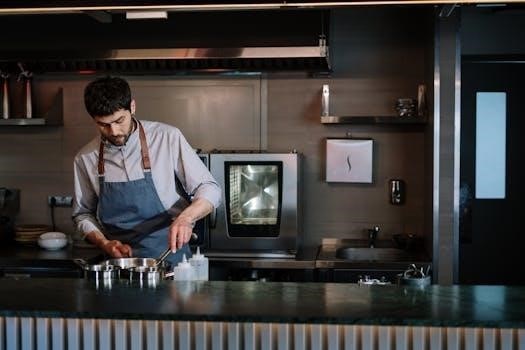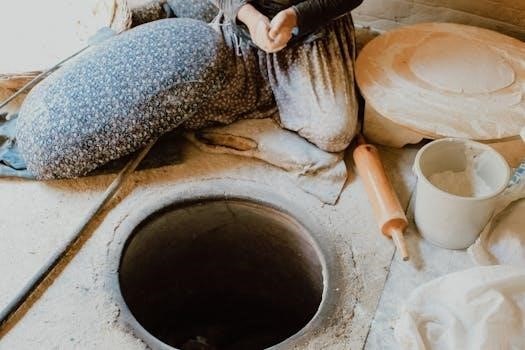Okay, here’s the text for the section⁚

GE Double Oven Gas Range Manual⁚ A Comprehensive Guide
Welcome to your comprehensive guide for your GE Double Oven Gas Range! This manual will provide you with everything you need to know, from safety precautions to operating instructions․ Learn how to maximize its features!
Okay, here’s the text for the section⁚
GE double oven gas ranges offer a versatile cooking experience, combining the precision of gas cooking with the convenience of two separate ovens․ This design allows for cooking multiple dishes simultaneously at different temperatures, saving time and effort in the kitchen․ These ranges come equipped with various features, including convection cooking (on some models), self-cleaning options, and precise temperature controls, enhancing your overall cooking capabilities․ GE appliances owner’s manuals offer use and care guidelines, installation instructions and feature guides․ Understanding the specific model and its unique functionalities is key to maximizing its potential․ Explore this guide to unlock the full potential of your GE double oven gas range․
Okay, here’s the text for the section⁚

Understanding Your GE Model Number
Your GE model number is key to accessing specific information about your range․ This section will guide you in locating and decoding this crucial identifier to find the correct manual․
Okay, here’s the text for the section⁚
Locating the Model Number
Finding the model number on your GE double oven gas range is the first step to accessing the right resources․ Typically, it’s located in a few common places․ Check the front frame of the oven, often visible when the oven door is open․ You might also find it on a sticker or plate at the back of the range․ Some models have the model number located on the side․ Look for a series of letters and numbers, as this identifies your specific model․ Once found, you can retrieve the correct manual online, or call GE’s support line․
Decoding the Model Number
Your GE double oven gas range model number isn’t just a random string; it’s a key to understanding your appliance’s features․ The initial letters usually indicate the type of appliance and series․ Numbers often signify the size or specific features․ For instance, “JGBS” might represent a gas range, while the following digits could specify the oven’s capacity․ Later letters can denote the color or finish․ By understanding these codes, you can quickly identify key characteristics․ This knowledge is useful when ordering parts, accessing specific manuals, or understanding the capabilities of your GE appliance․

Safety Information and Precautions
Your safety is paramount․ This section outlines crucial guidelines for operating your GE double oven gas range․ Familiarize yourself with these precautions to minimize risks and ensure safe operation․
Important Safety Instructions
Before operating your GE double oven gas range, thoroughly read and understand all safety instructions to minimize the risk of fire, electric shock, personal injury, or property damage․ Always ensure proper ventilation when using the range․ Never store flammable materials near the cooktop or in the oven․
Do not operate the oven or cooktop if the glass is broken․ Keep the area around the range clear of combustible materials․ Supervise children when the range is in use․ In the event of a gas leak, evacuate the area immediately․
Avoiding Gas Leaks
Preventing gas leaks is paramount for your safety․ Regularly inspect the gas supply line connected to your GE double oven gas range for any signs of damage or wear․ If you detect a sulfur-like odor, which indicates a potential gas leak, do not operate any electrical switches or appliances․
Immediately evacuate the premises and contact your local gas company or emergency services from a safe location․ Ensure that all connections are properly tightened during installation or maintenance․ Schedule professional inspections periodically․ Never attempt to repair gas lines yourself․
Operating the Surface Units
This section explains how to effectively use the surface units of your GE double oven gas range․ Learn about burner controls and selecting proper cookware for optimal performance․
Using the Burner Controls
To operate the surface burners on your GE gas range, first, locate the control knobs on the front panel․ Push the desired knob in and turn it counterclockwise to the desired flame height setting․ The hot surface indicator light will illuminate when the unit is hot to the touch and will stay on after the unit is turned off․ At both OFF and HI the control knob will stay on even after the unit is turned off․
Selecting the Right Cookware
Choosing the correct cookware is crucial for optimal performance on your GE gas range․ Stainless steel and porcelain enamel-covered cast iron cookware are both recommended for use․ Aluminum cookware is also suitable, but caution is advised when using cast iron cookware․ Ensure the cookware has flat bottoms large enough to cover the surface unit heating element․ The use of undersized cookware will expose a portion of the surface unit to direct contact and may result in ignition of clothing․

Operating the Ovens
Master the art of oven operation! This section covers baking, roasting, and broiling techniques, plus convection cooking if your model has it․ Learn to optimize your GE double oven gas range’s capabilities․
Baking and Roasting
Achieve baking and roasting perfection with your GE double oven gas range! This segment details essential techniques for consistently delicious results․ Learn about rack placement for optimal heat distribution, ensuring even cooking․ Discover how to use the temperature probe (if equipped) for precise roasting․ Understand the preheating process and its impact on baking quality․ Master adjusting cooking times based on food volume and oven load․ Explore the advantages of convection baking for certain recipes․ Discover the nuances of baking different types of goods from delicate pastries to hearty roasts, ensuring optimal performance․
Broiling Techniques
Unlock the secrets to perfect broiling with your GE double oven gas range․ This section provides you with expert broiling guidance․ Learn about high and low broil settings and when to use each․ Understand the importance of rack positioning relative to the broiling element․ Discover how to properly preheat the broiler for optimal searing․ Master the art of monitoring food closely to prevent burning․ Explore the benefits of using a broiler pan for efficient fat drainage․ Learn about the “broil stop” door position and its role in maintaining oven temperature․ Explore tips for successful broiling various foods such as meats and vegetables․
Convection Cooking (if applicable)
If your GE double oven gas range is equipped with convection capabilities, then prepare to revolutionize your cooking! Convection cooking uses a fan to circulate hot air, ensuring even heat distribution and faster cooking times․ Learn how to activate the convection mode on your range․ Discover the benefits of convection baking for pastries and desserts․ Understand how to adjust cooking times and temperatures for convection cooking․ Explore the advantages of convection roasting for meats and poultry․ Discover how convection helps to achieve crispy exteriors and moist interiors․ Delve into tips for optimal rack placement during convection cooking․ Find conversion charts to easily adjust your favorite recipes․
Cleaning and Maintenance
Keeping your GE double oven gas range clean is essential for optimal performance and longevity․ This section provides detailed instructions on cleaning various parts, including the cooktop and ovens, with ease․
Cleaning the Cooktop
To maintain the appearance and performance of your GE double oven gas range, regular cooktop cleaning is crucial․ Ensure the cooktop is cool before starting․ For everyday spills, use a soft cloth or sponge with warm, soapy water․ Stubborn stains may require a cooktop cleaner specifically designed for gas ranges․ Avoid abrasive cleaners or scouring pads, as they can scratch the surface․ Wipe away any cleaner residue with a damp cloth and dry thoroughly․ For grates, remove and wash them in the sink with soapy water․ Make sure to completely dry the components․
Cleaning the Ovens (Self-Cleaning Feature)
Your GE double oven gas range may feature a self-cleaning function to simplify oven maintenance․ Before initiating the self-clean cycle, remove all racks and accessories from the oven․ Wipe away any loose debris or excessive spills․ Refer to your model’s manual for specific self-cleaning instructions, as cycle times and settings may vary․ During the self-clean cycle, the oven will reach high temperatures to burn off residue․ Ensure the kitchen is well-ventilated․ Once the cycle is complete and the oven has cooled, wipe away any remaining ash with a damp cloth․ Avoid harsh chemicals․
Troubleshooting Common Issues
Encountering issues with your GE double oven gas range? This section addresses common problems like ignition failures and uneven cooking․ We’ll provide helpful tips and solutions to get your range back in working order․
Ignition Problems
Experiencing difficulty getting your GE gas range burners to ignite? Several factors can contribute to this issue․ First, ensure the range is properly connected to a power source, as the igniter requires electricity․ Check if the burner ports are clogged with debris; clean them carefully with a wire or pin․ A faulty igniter could also be the culprit․ Observe if the igniter sparks when you turn the knob; if not, it may need replacement․ Gas supply issues can prevent ignition, so check the gas shut-off valve․ Contact GE support if problems persist․
Uneven Cooking
Uneven cooking in your GE double oven gas range can be frustrating, but several factors might be responsible․ First, ensure proper oven rack placement․ Overcrowding the oven restricts airflow, leading to uneven heating; bake in smaller batches․ Verify oven calibration; incorrect temperature settings cause inconsistent results․ Check the oven door seal for damage, which can lead to heat loss․ Use appropriate cookware that distributes heat evenly․ If using convection, ensure it’s correctly activated․ Clean the oven regularly to prevent hot spots caused by accumulated grease․ Contact GE support for further assistance if the issue persists․
Warranty Information and Support
This section details your GE Double Oven Gas Range warranty coverage, offering guidelines on understanding the terms and conditions․ It also provides resources for contacting GE support for assistance․
Understanding Your Warranty Coverage
Your GE double oven gas range comes with a warranty, designed to give you peace of mind․ Review the documentation included with your range to fully understand the specifics of your model’s warranty coverage․ Pay close attention to the duration of the warranty period, typically covering parts and labor for a specific time after purchase․ The warranty usually covers manufacturing defects and malfunctions that occur during normal use․ However, it typically excludes damage caused by misuse, improper installation, or external factors like power surges․ Remember to register your range with GE Appliances to ensure your warranty is active and easily accessible․ Keep your purchase receipt handy, as it may be required for warranty claims․ Understanding these details will streamline any potential warranty service needs․
Contacting GE Support
If you encounter any issues with your GE double oven gas range that you can’t resolve using the troubleshooting section, reaching out to GE support is the next step․ GE offers multiple avenues for customer support, including phone, email, and online chat․ The GE Appliances website has a dedicated support section where you can find FAQs, product manuals, and contact information․ When contacting support, have your model number and serial number ready, as this will help the representative assist you more efficiently․ Be prepared to describe the issue you’re experiencing in detail․ If possible, provide photos or videos to illustrate the problem․ GE also provides support through its mobile app, allowing you to schedule service appointments and track your repair progress․ Remember to note the date, time, and name of the representative you spoke with for future reference․
